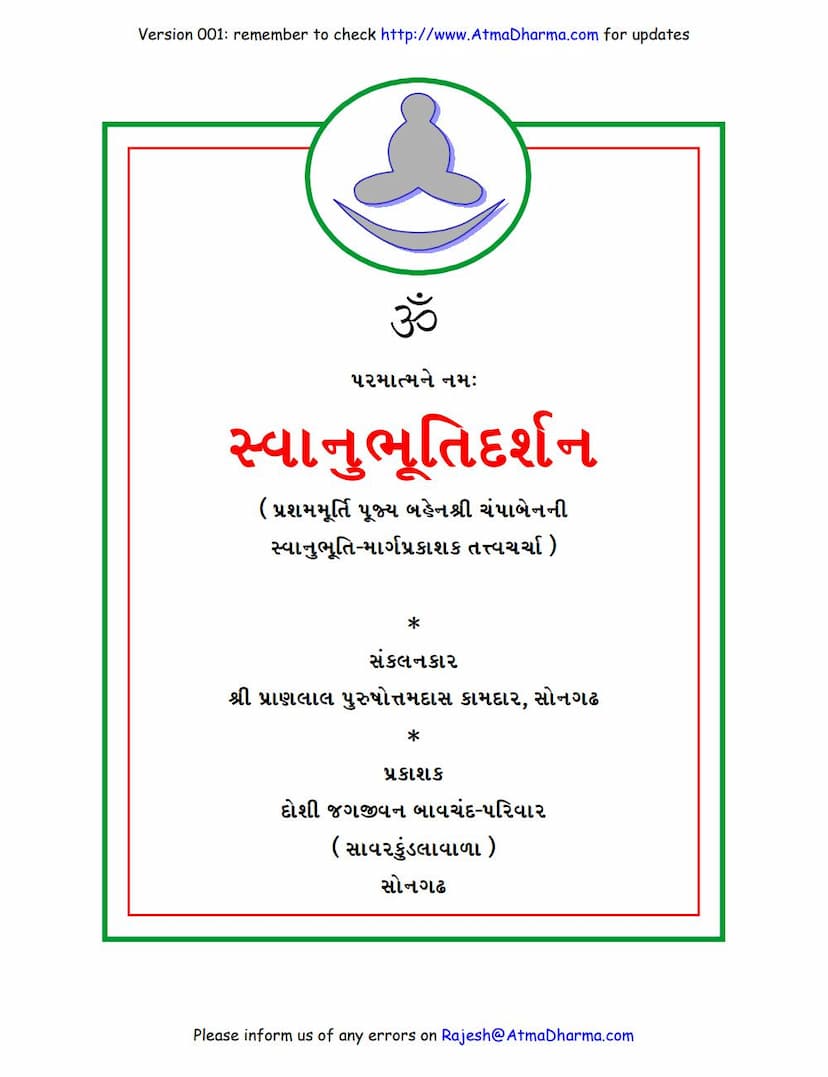Swanubhutidarshan
Added to library: September 2, 2025

Summary
This Jain text, "Swanubhutidarshan" by Champaben, is a compilation of spiritual discussions (tattva-charcha) held with the revered Acharya Shri Champaben. The discussions, compiled by Shri Pranalal Purushottamdas Kamdar, focus on the practical realization and understanding of the Soul (Atma) from a Jain perspective, particularly emphasizing the teachings of Acharya Shri Kanji Swami.
Here's a comprehensive summary of the key themes and content presented in the text:
Core Philosophy and Guidance:
- The Nature of the Soul (Atma): The central theme revolves around understanding the true nature of the Soul as distinct from the body, mind, and emotions (vibhava). The Soul is described as eternal, pure, inherently blissful, and characterized by infinite knowledge (gyanak), vision (darshan), and pure consciousness (chaitanya). It is the ultimate reality and the source of all happiness.
- Discernment (Bhedgnan): A significant emphasis is placed on the practice of discernment (bhedgnan) – the ability to differentiate the Soul from non-Soul entities (pudgal, karma, emotions, body, mind). This is considered the cornerstone of spiritual progress.
- Self-Enquiry and Inner Focus: The text constantly guides the reader towards introspection and withdrawing the senses and mind from external objects and experiences. The focus should be inward, towards understanding and experiencing the Soul.
- The Role of the Guru: The importance of a true spiritual guide (guru) is highlighted as instrumental in illuminating the path to self-realization. Gurudev's teachings are presented as the primary means to understand the subtle truths of the Soul.
- Effort and Persistence (Purusharth): While the Soul's nature is inherently pure and blissful, achieving direct experience (swanubhuti) requires diligent and persistent effort (purusharth). This effort is not about artificiality but about aligning one's focus and intention towards the Soul.
- The Goal: Self-Realization (Swanubhuti): The ultimate aim is the direct, experiential realization of the Soul, which leads to liberation (moksha). This is described as a state of unalloyed bliss, pure knowledge, and complete equanimity.
Key Concepts and Teachings:
- Dravya vs. Paryaya: The text often distinguishes between the eternal, unchanging substance (dravya) of the Soul and its transient states or modifications (paryaya). The Soul as dravya is pure and eternal, while paryayas are the soul's states of consciousness, which can be pure (shuddha) or impure (ashuddha/vibhava). The goal is to realize the dravya and its inherent pure nature.
- Gyan-Drashta (Knower-Seer): The Soul is identified as the pure Knower (gyatak) and Seer (drashta), detached from actions and experiences. The focus is on realizing this pure Knower-Seer consciousness.
- Vichara (Reflection/Contemplation): Deep contemplation on the nature of the Soul, its distinction from the non-Soul, and the teachings of the scriptures and guru is crucial for spiritual progress.
- Ruchi (Inclination/Attraction): True spiritual progress arises from an inner inclination and attraction towards the Soul. This inner attraction is considered more potent than mere intellectual knowledge.
- Vairagya (Dispassion): Dispassion towards worldly pleasures and worldly phenomena is essential to turn the focus inward. This dispassion arises naturally from the realization of the Soul's inherent bliss.
- Svadharma and Paradharma: Understanding and living in one's own true nature (svadharma) while recognizing and disidentifying from external influences or impure states (paradharma/vibhava) is key.
- Bhedgnan (Discernment): The ability to differentiate between the Soul and non-Soul is paramount. This discernment helps break the illusion of self with the transient and impure.
- Nirvikalpa Samadhi: The ultimate state of pure, uninterrupted meditation or absorption in the Soul is described as nirvikalpa dasha, where all dualities and thoughts cease, leading to direct experience of the Soul.
- The Importance of the Guru's Grace: The teachings emphasize that while self-effort is necessary, the grace and guidance of a living Master (guru) are invaluable in illuminating the path and dispelling doubts.
Structure and Content:
The book is structured as a series of questions and answers, reflecting a dialogue between seekers and a spiritual teacher. This Q&A format allows for the exploration of various spiritual dilemmas, doubts, and the practical application of Jain philosophy to daily life and inner transformation.
The discussions cover a wide range of topics, including:
- The distinction between Self and non-Self: Repeatedly addressed to help seekers realize their true nature.
- The nature of knowledge, vision, and conduct: How these manifest in the Soul and how to cultivate them.
- The process of spiritual practice: Emphasis on contemplation, self-enquiry, and detachment from worldly concerns.
- Dealing with obstacles: Guidance on overcoming doubt, mental distractions, and the inertia of past conditioning.
- The role of karma and external factors: While acknowledging the influence of external circumstances and past actions (karma), the primary emphasis remains on the Soul's inherent capacity for liberation through self-effort.
- The characteristics of a true seeker: What qualities are necessary to progress on the spiritual path.
Overall Message:
"Swanubhutidarshan" is a profound guide for sincere seekers aiming for self-realization. It emphasizes that the path to the Soul's realization lies within, requiring deep introspection, unwavering devotion to the truth, persistent effort, and the grace of a true Guru. The book encourages a shift in perspective from the external and transient to the internal and eternal Soul, leading to lasting peace, bliss, and liberation.